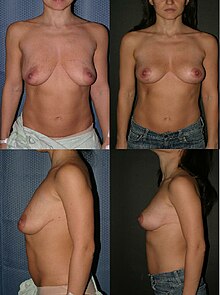Mastopexy
The breast lift or mastopexy is a method of raising and reshaping of sagging, drooping breasts .
description
In mastopexy, depending on the technique used, deep nipples are sometimes also brought into a higher, "youthful" position and often also made smaller. It may be that with a small breast, for example with loss of volume after pregnancy, an enlargement of the breast is also desired. This can be achieved through breast implants , which can be inserted during a breast lift surgery.
The operation can change the shape, firmness and size of the breast. In addition, the operation can even out major inequalities in the breast (asymmetries). The ability to breastfeed is not limited by the breast lift usually. When planning a breast lift, however, it should be noted that another pregnancy can lead to sagging of the breasts again, so postponing the operation to a later date may be useful. In principle, however, the results of a mastopexy are not permanent, and the long-term results are not very convincing.
The course of the scars corresponds to that of the breast reduction , ie around the areola and vertically into the lower breast fold, depending on the technique, also running in an inverted T or L shape in the breast fold.
Before each operation, there is a comprehensive explanation of possible complications and treatment options by the plastic surgeon.
techniques
Technique with an inner bra
The technique of the inner bra is a modern technique which is supposed to counteract the renewed sagging and sagging of the breast. Here, part of the excess skin is used as a support like a tight belt in the lower part of the chest. The chest rests on two sewn reins and therefore remains in the tightened position. This demanding method of breast tightening results in a significantly longer tightening compared to the standard methods.
Benelli technique (round-block technique)
With this method of breast lift, which is also known as the round block technique and which was named after the French surgeon Louis Benelli, the breast lift is carried out through an incision around the areola. The fat and glandular tissue located under the nipple is reduced. The breast loses a little volume and with the simultaneous displacement of the nipple the whole breast is tightened.
Lejour technology
The Lejour breast lift, which is named after the Belgian surgeon Madeleine Lejour, is also known as a vertical breast lift. Different cuts are combined with one another. With this method of breast lift, the first incision is made around the nipple, followed by a vertical incision down to the underbust fold. This allows excess skin to be removed from both the upper and lower chest areas. In the last step, the skin below the nipple is pulled together.
Inverted T technology
The T-technique gets its name because of the special cut: As with the vertical technique, an incision is made around the areola and a vertical incision is made towards the underbust fold. However, since these cuts alone would not be sufficient for heavily sagging breasts, an additional horizontal cut is made in the crease of the breast with the T-technique. This results in an inverted “T” below the nipple. With this method of breast lift, the excess skin is completely removed, both lengthways and crossways, so that no skin wrinkles remain on the incision.
history
Reconstructive breast surgery has been documented in writing since at least 1669. In 1854 Alfred-Armand-Louis-Marie Velpeau described in detail the ptosis of the female breast . Mastopexy techniques were first described at the end of the 19th century, for example by Michel Pousson and Verchère. In Germany, Dehner performed a mastoplexy for the first time. By the late 1930s, the technicians were refined, including by Erich Lexer and Hans Kraske (Lexer-Kraske-Mammaplastie). Modern techniques were established by Strombeck and McKissock, among others. The round-block technique was introduced by Louis Benelli in 1990.
literature
- Alfred Berger, Robert Hierner: Plastic Surgery: Mamma. Tribe. Genitals. Springer, 2007. ISBN 978-3-540-68842-6 . P. 139ff.
- Manfred Kaufmann, Ismail Jatoi, Jean-Yves Petit (eds.): Atlas of breast surgery. Springer, 2008. ISBN 978-3-540-48882-8 . P. 116ff.
- Werner L. Mang (Ed.): Tips and tricks for the aesthetic plastic surgeon: Problem solutions from A - Z. Springer, 2007. ISBN 3-540-28409-5 . P. 119ff.
- Melvin A. Shiffman (Ed.): Mastopexy and Breast Reduction: Principles and Practice. Springer Science & Business Media, 2009. ISBN 978-3-540-89873-3 .
Individual evidence
- ↑ Kaufmann: Atlas of breast surgery. P. 116
- ↑ a b c Breast lift Hamburg: firm breasts. In: Praxisklinik Colonnaden. Retrieved February 3, 2020 (German).
- ↑ Breast reduction: Benelli operation using the O method. Retrieved February 3, 2020 .
- ↑ a b Jorge de la Torre, James Long, Luis Vásconez: History of Mastopexy. In: Shiffman: Mastopexy and Breast Reduction: Principles and Practice. P. 43ff.
- ↑ Michel Pousson De la mastopexie. In: Bulletin et memoires de la Societe des chirurgiens de Paris 23, 1897. p. 507
- ↑ F. Verchère: Mastopexie laterale contre la mastoptose hypertrophique. In: Médicine moderne 9, 1898. pp. 540f.
- ↑ J. Dehner: Mastopexy to remove the neck breast. In: Münchner Medizinische Wochenschrift 55, 1908. S. 1878f.
- ^ Ivo Pitanguy: Aesthetic Plastic Surgery of Head and Body. Springer Science & Business Media, 2012. ISBN 978-3-642-66910-1 . P. 4f.
- ^ JO Strombeck: Mammaplasty: Report of a new technique based on the two-pedicle procedure. In: British Journal of Plastic Surgery , April 13, 1960. pp. 79-90
- ↑ PK McKissok: Reduction mammaplasty by the vertical bipedicle flap technique. Rational and results. In: Clinics in Plastic Surgery 3, 1976. pp. 309-320
- ^ Louis Benelli: A new periareolar mammaplasty: The "round block" technique. In: Aesthetic Plastic Surgery December 1990, Volume 14, Issue 1. pp. 93-100
